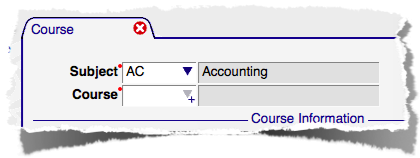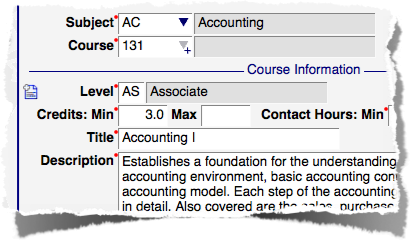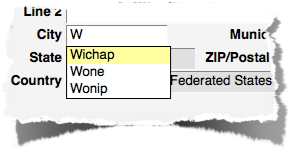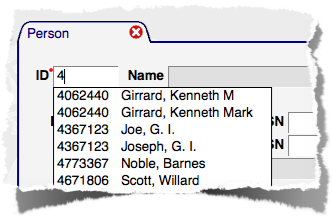|
|
TutorialTable of contents
FormsInformation contained in the student database is created, viewed and modified using forms. Each form is designed to manage information from a specific functional area of the database, and typically covers one or two closely related types of records. The Person form, for example, is used to manage biographical information and includes basic information like date of birth and gender, along with address information. Individual forms will never manage information from multiple functional areas. This restriction helps keep information more logically organized, and makes security easier to manage. A form may display information from another area when appropriate, but updating that information won't be possible. The Award Package form for financial aid is a good example; it displays a summary of student data that is relevant to their receiving financial aid awards, but the information can't be modified. Form ElementsAll forms display and manage information in similar ways, and this tutorial covers topics that are common to how all forms operate. Understanding and using the large number of forms that are part of the student database is easier than you may expect, mainly because they all operate in a similar way. The Course form provides a good example of how forms work. It includes most of the elements used in all forms. We'll cover other elements using the (???) form later. If you haven't read the Overview already, please take the time now to do so. Many aspects of how forms work are introduced there and may not be described again below. Key ValuesThe Course form manages information in the course catalog, which include course titles, credits, co- and pre-requisites, and course fees. Each course is identified by a unique combination of a subject and course number. Subject and course number are "key values" on the Course form, used to identify one specific course to create, display, or modify its information.
The Course field is also a select list, but its contents are dependent on Subject. When forms have multiple key values, they become increasingly specific as they're listed from left to right or top to bottom. The Course list only contains values for courses having the Subject you've already entered. In the example above, no Accounting courses exist so the list is empty (indicated by a grey triangle). If you are displaying or modifying an existing course you can select it from the list. If you're creating a new course you can simply type in the course number (note that this select field has a + next to the triangle to indicate that new values may be added). The combination of the two fields identifies a specific course, so it isn't necessary or appropriate to include the subject code in the course number. The course "AC 131" has the subject "AC" and a course number of "131." Both Subject and Course are required fields (indicated by the red dot next to the field label). Since both are key values, both must be specified before any data may be entered in the remainder of the form. Note: Any time a form's key values change, records are requested from the database that match the new values. If data is already present on the form, it will be replaced with information from the database that matches the new key values! This is especially important when creating new records. If you specify a course number (for example), complete the remainder of the form, then decide you need to alter the course number, you may lose the data you've entered (you'll be prompted to verify that you want to discard the changes). FieldsThe details for each course are entered in various fields in the Course Information portion of the form. Each field will expect a specific type of information to be supplied, and some may be validated.
The Credits fields (Min and Max) expect numbers. Note that only Min is required. All numeric fields will have a limit on the size of the value entered, and will reformat what you enter to a field-specific precision. Credits, for example, has one place to the right of the decimal and must be less than 100. Title is a plain text field. It will have a limit on how many characters of data it can hold, but isn't checked or limited in any other way. Description is similar, but can accept much more information. Both are required to contain some value. In this example we're creating a new record for AC 131, indicated by the icon to the left of the Level field. Each grouping of information on a form will have an indication of whether the data is new, modified, or locked. TablesFurther down the Course form we have a table of Course Requisites. Tables are built using fields exactly like those we have used elsewhere on the Course form.
We're creating a new Requisite, so the row number is amber to indicate that it has not been saved to the database. Tables indicate any unsaved changes, including deleted rows, with the same amber row number. The right-most column is the delete control. Checking the delete control in a table row will indicate that a record should be deleted when the form is submitted. Controls
The Reset button removes all data from the form and resets it for entry of new information. If you have changed or added any information, you'll be prompted to verify that you want to discard the changes; clicking Cancel will return you to the form and allow changes to be saved. The Submit button requests that any new, modified, or deleted data be recorded in the database. Until submitted, any changes or additions you've made have not been saved. If anything prevents the changes from being recorded, you will be alerted to the nature of the problem. Indicators on the form (icons, etc) indicating pending changes will only disappear when data has successfully been saved. Some forms also have a Print button to allow the form contents to be sent to a printer. Only forms built specifically to support printing will have this button. Examples include the Student Schedule and Online Transcript.
All forms are closed using the red close control in the form's tab. If there are any changes to data on the form that have not been saved, you'll be prompted to verify that you wish to discard them. Suggest FieldsSome fields will provide suggestions for possible values, either when you have typed part of a value or simply based on information entered in other fields. The most common field providing suggestions is ID number, used to locate a person in the database. Because it is used so frequently and the need to match known people is so important, it has some special qualities. All suggest fields match what you've typed so far against a list of known values.
In this case, you are not limited to known city names, the suggestions are there merely as an assist during data entry.
IDs and NamesWhen entering ID numbers we're trying to identify people, but since an ID number isn't always readily available, it's often necessary to look for people by name instead. A maximum of fifty suggestions will be listed, so for common names or small portions of an ID number, you may not see a complete list of possible matches. Supply more information to narrow down the list of suggestions. Notice that two people in this example have two variations of their name displayed. Name changes were made and the prior names left in the database. It is easy to leave prior names in the database, and the matching performed by ID fields will include them, making it easier to find them. When a name is selected (by clicking on the suggestion) the current ID and name is always displayed on the form. When entering names the "Last, First" format is strictly matched, so if you need to match on first name you must enter the complete last name, the comma and a space before starting the first name. If you are unsure of the spelling or have partial information, the Identity Search form is a better way to search for an ID number. |

 The top of the Course form contains two select lists. The first, labeled Subject, contains a list of all the
The top of the Course form contains two select lists. The first, labeled Subject, contains a list of all the  Level is a validated field and is required (it has that red dot). Most validated fields display a description to their right, which can't be modified. The list of valid level codes can be found on the
Level is a validated field and is required (it has that red dot). Most validated fields display a description to their right, which can't be modified. The list of valid level codes can be found on the  Requisites are other courses that must be completed before or taken concurrently with a course. As described above, courses are identified with a unique combination of subject and course number, so each requisite includes that information and a Requisite Type of P (pre-requisite) or C (co-requisite). Subject is a validated field, and Subject and Course together must identify a known course (the combination of both is validated against all defined courses). Title is the course title matching the entered Subject and Course, MS 098 in this example.
Requisites are other courses that must be completed before or taken concurrently with a course. As described above, courses are identified with a unique combination of subject and course number, so each requisite includes that information and a Requisite Type of P (pre-requisite) or C (co-requisite). Subject is a validated field, and Subject and Course together must identify a known course (the combination of both is validated against all defined courses). Title is the course title matching the entered Subject and Course, MS 098 in this example. All forms have a set of buttons at the bottom of the form to perfom common tasks.
All forms have a set of buttons at the bottom of the form to perfom common tasks. If the form or your access don't allow data to be modified, the Submit button won't be displayed.
If the form or your access don't allow data to be modified, the Submit button won't be displayed. The City field in addresses consults a list of known city names that also includes municipality, state, ZIP, and country code. Matching a known city brings all of the related information into the form as well, helping improve accuracy and completeness of address information.
The City field in addresses consults a list of known city names that also includes municipality, state, ZIP, and country code. Matching a known city brings all of the related information into the form as well, helping improve accuracy and completeness of address information. All ID number fields allow searching by name or ID, checking prior names and IDs as well. In the example show at right, only a "4" has been entered, so the list includes people whose ID number begins with the digit "4." If "47" had been entered, the list in this example would already be narrowed down to one individual.
All ID number fields allow searching by name or ID, checking prior names and IDs as well. In the example show at right, only a "4" has been entered, so the list includes people whose ID number begins with the digit "4." If "47" had been entered, the list in this example would already be narrowed down to one individual.